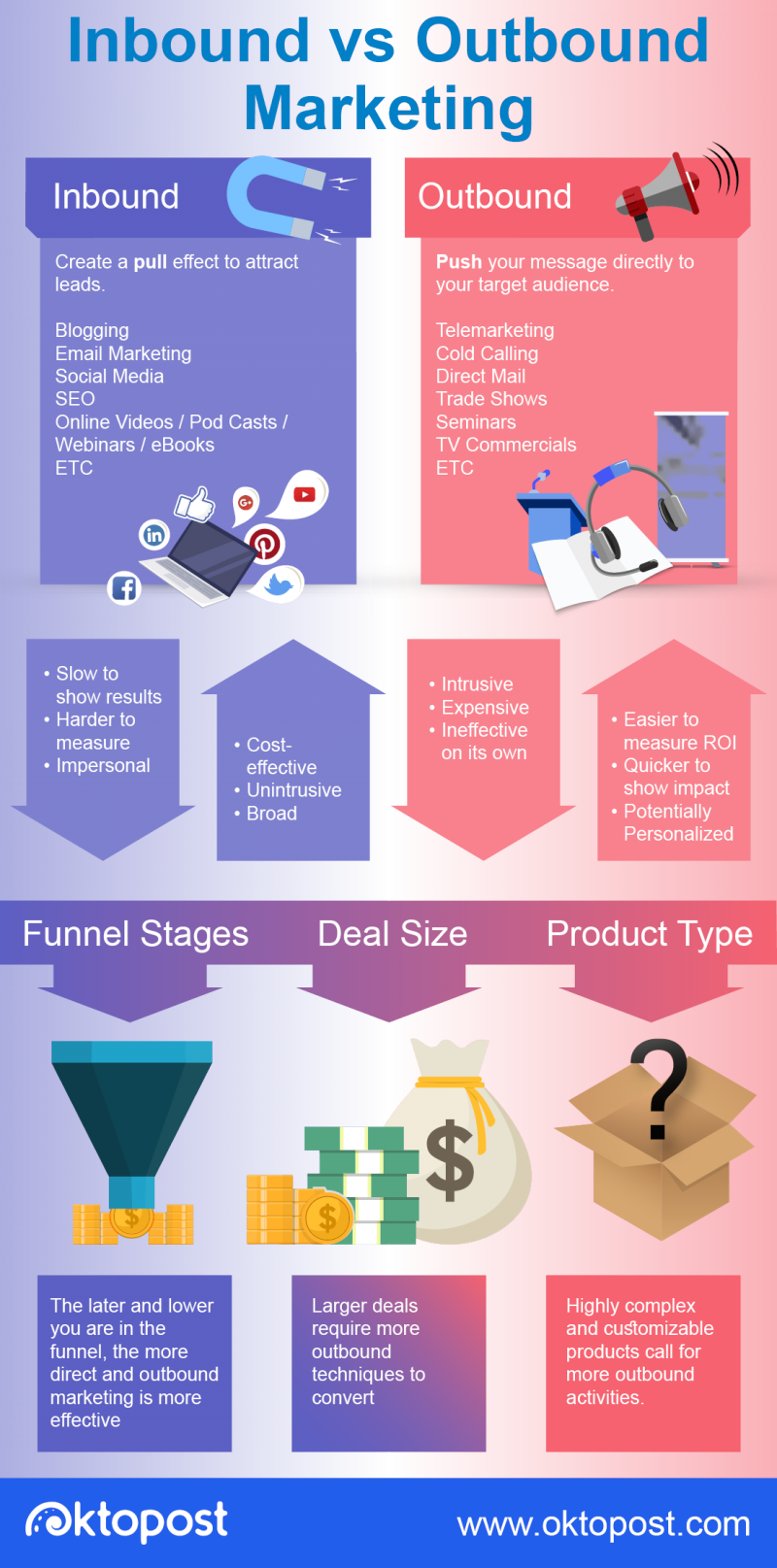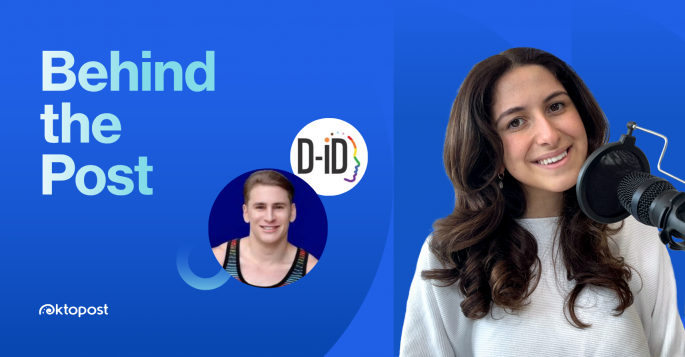![How to use inbound vs outbound marketing [complete guide]](https://cdn-www.oktopost.com/blog/wp-content/uploads/2019/06/campaign-creators-771730-unsplash.jpg)
How to use inbound vs outbound marketing [complete guide]
Should I use inbound or outbound marketing? The short answer to that question is usually “both”. Not a very helpful answer to a marketer working on a strategy to maximize ROI. With every marketing dollar carrying the heavy tax of justifying its spending to management, you simply can’t shoot in all directions hoping to hit a lead.
Sign-up to watch our informational webinars on inbound and outbound marketing here.
Where do you find that balance between outbound and inbound marketing to maximize and grow the flow of leads? What should you consider when concocting a synergic marketing mix to include both? When in the funnel should you be investing more in which of the two? To answer all these questions, let’s start by understanding each of the marketing techniques, its strengths and weaknesses.
What is Outbound marketing?
Outbound marketing can be simply described as a straightforward business exchange proposition. “Hey there, want to buy my thing?” is your basic message and approach of outbound marketing. It’s the oldest and most fundamental part of any marketing strategy, and is also what non-marketers assume marketing is all about.
Examples of outbound marketing include telemarketing (“cold calls”), paid mailings (both electronic and “snail mail”), advertising (banner ads, radio ads, billboards, etc.) and even door-to-door sales. It’s all about reaching out and pulling the prospect in. However, keep in mind that outbound and inbound are not just about the medium but also about how we use those mediums to deliver a message to our audience. With outbound, as mentioned above, the message is like a focused laser. Below, I drill down further into the differences – if you want the tl;dr check out this useful infographic.

Strengths of outbound marketing
Not only is it the older and better polished set of techniques, outbound marketing generates sales leads almost immediately. It goes beyond saying that it’s no magic wand, but when it comes to “sealing the deal”, your go-to tools are those in your outbound toolbelt.
1. Easier to measure ROI
One of the many reasons marketers default to traditional outbound marketing is the ease of conversion measurement. Display ads, for example, offer friendly analytics showing you which ads and what placements drove online sales. Cold calls end with an eventual purchase or a refusal, which is pretty binary when you look at it. Even with mass media advertising like television and radio, measuring the impact on sales and lead qualification is not impossible.
2. Quicker to show impact
If you’re doing it right, outbound marketing can start showing results almost instantly. A seasoned expert can have a promotional campaign up and running across ad networks in a day or two. With that, leads (or purchases!) can potentially start flowing in as soon as the ad begins to appear in relevant placements.
3. Potentially personalized
Many outbound marketing techniques can be individually tailored for each potential buyer or client. For example, “cold calls” aren’t always ice cold. They can be hyper-personalized if you have prior data on the business and contact you’re reaching out to. Email marketing can have a personal effect if you use the data available on your lead.
Weaknesses of outbound marketing
Many businesses and brands love outbound marketing for its quick and easily measured results. However, they equally hate the cost and too often the reaction of the target audience, which can easily manufacture a negative sentiment toward the brand.
1. Intrusive
Show of hands, please: Who likes telemarketers and unsolicited emails? What, no one? No surprise there! Outbound marketing can be intrusive (though it doesn’t have to be). It interrupts the users’ experience or train of thought with a marketing message that might not always be relevant to them at that specific time.
2. Expensive
Telemarketers, banner ads, and mass media ads are expensive. Even if you’re an optimization genius, there’s a price tag on every click and every conversion, and possibly even a bonus for the telemarketer.
3. Ineffective on its own
Using “push” techniques alone and relying on outbound marketing alone throughout the sales funnel is only effective in a very small percentage of cases or on a small scale. When it comes to most brands and businesses, outbound marketing requires the support of many inbound marketing tools. This is especially true when it comes to collecting the data necessary to move forward with the lead qualification process with outbound activities.
Recommended for further reading
What is inbound marketing?
In short, the idea of inbound marketing is to create a pull effect to bring in pre-qualified leads instead of pushing intrusive messages to “fish” for them.
Inbound marketing activities include opt-in email marketing, content production and promotion, social media, and search engine optimization efforts (SEO), among other things. However, once again, it’s not just about the medium but also about the message itself. With inbound, the purpose is to try and “pull” in members of our target audience with messages and offers that, potentially, have wider appeal.
Using this method, a type of funnel is created with leads coming in at the top of the funnel (TOFU) and being “nurtured” down the funnel with marketing messages tailored to the stage that the lead is in until they are “ready” to be approached with a message directed to start the purchasing process.
Inbound marketing is a relatively new approach, born in the age of digital marketing. However, it has existed long before and the activities we now tag as inbound marketing fell under the branding and positioning umbrella.
For example, decades ago a manufacturer of cars could place a sponsored article in a motorist magazine discussing modern safety features in new family-oriented vehicles. Of course, their newest models would feature all the advanced and additions mentioned in the article. With that article in the back of their minds, potential buyers are more likely to favor that brand when selecting a family vehicle.
Strengths of inbound marketing
Though it existed long before social media and even online sales, the inbound methodology has taken over digital advertising by storm in the past decade. With growing banner blindness, do-not-call lists and the rising cost of users’ attention, it’s no wonder so many brands and businesses include inbound marketing in their strategies.
1. Cost-effective
Before you start moving uneasily in your chairs – Yes, inbound can be more cost-effective. While it might not be instantly apparent, inbound marketing should give you more bang for the buck over time. Content created once can continue to attract potential clients and form their sentiments toward your brand for years to come. In addition, many inbound marketing activities have little to no cost at all. This is made possible by a plethora of automation and social media management solutions available for free or for a modest fee.
Of course, there are a lot of “if”s that can be interjected here. Inbound efforts work best when a demand is already there. Then, it’s “just” a matter of beating your competitors for your customers’ attention.
2. Unintrusive
Unlike outbound marketing, inbound marketing is about being there at the right time and with the right content to attract buyers. It’s about relevance. So instead of mass-mailing clients, for example, it would be wiser to invest in being found online for relevant keywords (SEO).
3. Broad
A single cold call can reach exactly one person. A well-crafted and informative article or video can have thousands of people entering your sales funnel with a positive sentiment toward your brand. Obviously, content should still be targeted for your audience / demographic, but you’re not constantly scouring for new leads due to the broad reach that content can have through organic search or social media.
Weaknesses of inbound marketing
For B2B marketers, it’s often hard to explain the value of inbound marketing to executives who just want to see those leads flowing in and converting. It’s no longer a new approach and methodology, and yet there are reasons brands sometimes hesitate to prioritize inbound marketing activities.
1. Slow to show results
In most cases, a few well-timed social media posts or a good informative blog post are not going to have the phones in the sales department ringing off the hooks. Even if you employ inbound PPC channels like Google Search ads you’ll still need to work leads down the funnel, which takes time. Inbound can, however, contribute to the critical process of lead nurturing – that magical path people take from the moment they hear about you, and the moment they purchase from you.
2. Harder to measure
Although there are numerous approaches, tools and techniques, measuring the impact of inbound marketing on the overall volume of sales is hard. Not only are results slow to appear, but inbound marketing activities can be described like little drops making up the wave that sweeps leads your way. How does one quantify the contribution of each drop, and when?
3. Impersonal
Having a broader reach and appeal, inbound marketing is not a direct one-on-one conversation between the potential client and you. As such, it usually earns less engagement and immediate response from the potential client.
Brewing your marketing mix
Let’s go back to the question we started with: which should you be using – inbound or outbound? And the answer: both. Understanding the strengths and weaknesses of each, you can see why both are necessary ingredients in your marketing mix. But how much of each, and when?
A number of variables affect the inbound to outbound ratio of every brand, product, campaign, and even specific transaction. The impact of some might be less than of others, depending on your unique business and product.
Deal size
Traditionally, when it comes to B2B marketing the major differentiator from the B2C world is deal size. Outbound marketing is very resource-intensive. It requires segmented email flows, hiring Sales Development Managers, a sales team, and everything that goes along with it. For this to make sense, the average deal size that they end up closing needs to be large enough for a positive ROI.
That said, a good example would actually come from the B2C world. One usually does not buy a house without getting personal treatment from a realtor. That personal treatment can make or break a deal, and so the bigger the potential income, the stronger you will lean toward outbound marketing.
Product type
Products are differentiated not only by the cost (and thus deal size) but also by the level of involvement and complexity of the purchase. For example, a single ad on YouTube or Facebook might get you interested in an app like Monday or Grammar.ly. However, when it comes to selecting an enterprise solution for remote worker collaboration, it’s going to take a lot more to get a foot in the door.
Outbound marketing is critical when it comes to products that require customization, personalization, or additional expenses such as infrastructure or employee education. However, one cannot ignore the importance of lead nurturing for high complexity and involvement purchase decisions.
Funnel stages
Perhaps the most important variable to influence the balance of inbound / outbound marketing in your mix is the stage of the funnel your lead is at. With inbound marketing working to nurture leads down the funnel, outbound marketing is there to seal the deal at the perfect time and convert that lead.
The marketing mix and match
Combining inbound methodologies and outbound marketing techniques in your marketing mix is not always easy, but is usually worth it. By defining the correct balance between the pull techniques of inbound and the push techniques of outbound, you can combine both to create an optimized lead nurturing and conversion process. It all depends on how well you know your target audience, and how willing you are to make the effort to cater to their needs along the journey down the funnel.
Find out more about inbound and outbound marketing by signing up for our informational webinars here.


